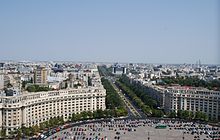Parliament Palace
The Parliament Palace (also Palace of Parliament , Romanian Palatul Parlamentului [ paˈlatul parlaˈmentului̯ ]) in the Romanian capital Bucharest , formerly known as the "House of the People" ( Casa Poporului [ ˈkasa poˈporului̯ ]), is one of the largest buildings in the world in terms of area. The centrally located palace is at the western end of the approximately three kilometer long Bulevardul Unirii . It is the seat of the Romanian Chamber of Deputies .
history
The building was built from 1983 to 1989 according to the ideas of the dictatorial Romanian President Nicolae Ceaușescu ; the official laying of the foundation stone took place on June 25, 1984. The architect of the building, Anca Petrescu (1949–2013), won the palace building competition right after completing her studies at the age of 26, and after completion she was mainly responsible for its design. In order to create space for the superlative structure, the overall complex of which also includes large parts of new squares and avenues, at the end of the 1970s some historic residential buildings with around 40,000 apartments, a dozen churches and three synagogues were demolished and parts of the old town were evacuated. The Mihai Voda monastery was also supposed to be demolished, but was spared after worldwide protests and instead moved a few hundred meters. Around 20,000 workers, mostly military personnel, built the palace in three shifts.
Originally the building was called Casa Poporului ( German House of the People ), which the Bucharest people mockingly referred to as the “House of Victory over the People”. After the Romanian Revolution and the execution of Ceauşescu in 1989, discussions flared up about the further use of the building. In April 1991 the decision was made that the building complex would not be demolished and renamed the “Palace of Parliament”. After further renovations, the building has served as the seat of the Romanian Chamber of Deputies since 1997 , and the Senate also moved into the palace in 2005 . There is also an international conference center where, for example, the NATO Parliamentary Assembly took place in April 2008 . An international customs and police organization is located on the upper floors. The National Museum of Modern Art is housed at the rear of the building.
Architecture and construction technology
The construction employed 20,000 workers and - depending on the source - 400 to 700 architects for more than five years. Its floor area is 65,000 m² , the built-up area 365,000 m² - for comparison: the pentagon measures 610,000 m². After the Pentagon, the palace is the second largest administrative building in the world. The largest gallery in the building is 150 meters long and the largest hall is 16 meters high and 2200 m². The construction costs are difficult to quantify, one estimate is 3.3 billion euros, which corresponds to up to 40 percent of Romania's annual gross national product .
style
Stylistically, the Parliament Palace is counted as neoclassicism . Its monumentality, however, identifies it as a pure ruling architecture and goes beyond any previously known framework of classicist and neoclassical models. British historian Tony Judt saw the palace as “a monstrous metaphor for excessive tyranny”.
Technical details
- Dimensions:
- Base area: 65,000 m²
- Height: 86 meters above the ground, 92 meters underground
- Length: 275 meters
- Width: 235 meters
- Numbers:
- Architects involved in the construction (led by Anca Petrescu): 700
- 5,100 rooms, of which 3,000 are rooms, the rest are halls and corridors (30 conference halls)
- over 30 rooms and salons are between 200 and 2,000 m² in size
- 200 toilets
- 31 elevators
- 480 chandeliers
- 150,000 light bulbs
- 52,000 m² of carpets
- 2,000 km of electrical lines
- Construction materials:
- 1,000,000 m³ of marble from Transylvania
- 3500 t of crystal glass , from which 480 chandeliers, 1409 ceiling lights and mirrors were made
- 700,000 tons of steel and bronze for monumental doors, windows and chandeliers
- 900,000 m³ of wood (walnut, oak, cherry, elm, plane tree, maple)
- 200,000 m² of gold and silver embroidered velvet and brocade curtains
Currently (2010) 170 technicians take care of the maintenance of the building. Since the electricity bill was 1.7 million euros in 2008, incandescent lamps are gradually being replaced by energy-saving lamps .
literature

- Robert Schediwy : Städtebilder , Lit Verlag, Vienna 2005, ISBN 3-8258-7755-8 , pp. 75–76.
- Paul Jeute : The Palace of the Parliament in Bucharest , Munich 2011, ISBN 978-3-640-95418-6 .
- Andrei Pandele: The House of the People. The end, in marble . Compania Publishing House, Bucharest 2009 (in English), ISBN 978-973-7841-76-6
- George Avanu: Bucharest. The Parliament Palace. Age-Art, Bucharest 2011. ISBN 978-606-92959-1-5 . (multilingual illustrated book)
Web links
- Neue Zürcher Zeitung , Martino Stierli: Built shadows of the past , February 4, 2005
- one day , Christoph Seidler: I need something big, something very big , April 2nd, 2008
- Palace of Parliament - Chamber of Deputies, Bucharest at Google Cultural Institute
Individual evidence
- ↑ a b one day : I need something big, something very big , by Christoph Seidler
- ^ Google Maps, Bulevardul Unirii
- ↑ a b castles and palaces. Archived from the original on March 18, 2017 ; accessed on March 17, 2017 .
- ↑ a b Huge Parliament Palace in Bucharest's city center . In: KLM.com . ( klm.com [accessed March 17, 2017]).
- ↑ a b c Süddeutsche Zeitung : Article about the architect and the building
- ^ Largest administrative building-world record set by The Palace of the Romanian Parliament ( Memento from May 15, 2012 in the Internet Archive )
Coordinates: 44 ° 25 ′ 39 ″ N , 26 ° 5 ′ 14 ″ E

